Abrasive Wear
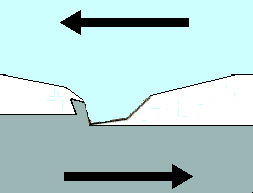
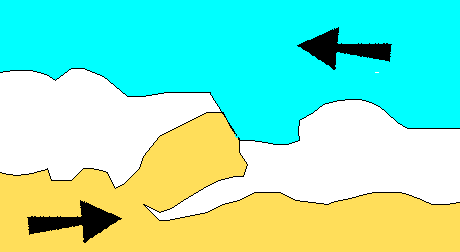
Two body abrasive wear
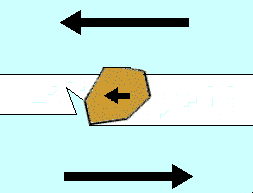
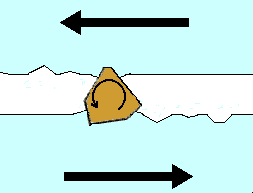
Three body abrasive wear
Wear
Loss of material from a surface by means of some mechanical action.
Abrasive Wear
Wear due to hard particles or hard protuberances forced against and moving along a solid surface.
Adhesive Wear
Wear due to localised bonding between contacting solid surfaces leading to material transfer between the two surfaces or the loss from either surface.
Erosion
Wear due to mechanical interaction between that surface and a fluid, a multicomponent fluid, or impinging liquid or solid particles
Cavitation Erosion
A form of erosion causing material to wear by the action of vapour bubbles in a very turbulent liquid.
Fatigue wear
Wear of a solid surface caused by fracture arising from material
fatigue.
Fretting Wear
Wear arising as a result of fretting (Small amplitude oscillatory
motion, usually tangential, between two solid surfaces in contact).
Reducing Wear by Using Thermal Spray Coatings
Thermal Spray Coatings for Soft Bearing Surfaces
Thermal Spray Coatings for Hard Bearing Surfaces
Thermal Spray Coatings for Resistance to Abrasion
Thermal Spray Coatings for Resistance to Fretting
Thermal Spray Coatings for Resistance to Erosion
Coatings for Low Friction and Non-stick Properties
The mechanism of wear is very complex and the theoretical treatment without the use of rather sweeping simplifications (as below) is not possible. It should be understood that the real area of contact between two solid surfaces compared with the apparent area of contact is invariably very small, being limited to points of contact between surface asperities. The load applied to the surfaces will be transferred through these points of contact and the localised forces can be very large. The material intrinsic surface properties such as hardness, strength, ductility, work hardening etc. are very important factors for wear resistance, but other factors like surface finish, lubrication, load, speed, corrosion, temperature and properties of the opposing surface etc. are equally important.




The abrasive wear mechanism is basically the same as machining, grinding, polishing or lapping that we use for shaping materials. Two body abrasive wear occurs when one surface (usually harder than the second) cuts material away from the second, although this mechanism very often changes to three body abrasion as the wear debris then acts as an abrasive between the two surfaces. Abrasives can act as in grinding where the abrasive is fixed relative to one surface or as in lapping where the abrasive tumbles producing a series of indentations as opposed to a scratch.
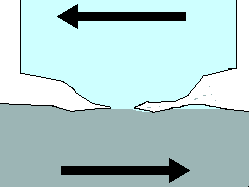
Adhesive wear is produced by the formation and subsequent shearing of welded junctions between two sliding surfaces. For adhesive wear to occur it is necessary for the surfaces to be in intimate contact with each other. Surfaces which are held apart by lubricating films, oxide films etc. reduce the tendency for adhesion to occur.
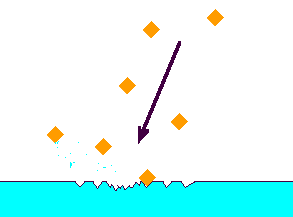
Erosion is caused by a gas or a liquid which may or may not carry entrained solid particles, impinging on a surface. When the angle of impingement is small, the wear produced is closely analogous to abrasion. When the angle of impingement is normal to the surface, material is displaced by plastic flow or is dislodged by brittle failure.
Cavitation is the formation and collapse, within a liquid, of cavities or bubbles that contain vapour or gas. Normally, cavitation originates from changes in pressure in the liquid brought about by turbulent flow or by vibration, but can also occur from changes in temperature (boiling). Cavitation erosion occurs when bubbles or cavities collapse on or very near the eroded surface. The mechanical shock induced by cavitation is similar to that of liquid impingement erosion causing direct localised damage of the surface or by inducing fatigue.
Fretting is a small amplitude oscillatory motion,
usually tangential, between two solid surfaces in contact. Fretting
wear occurs when repeated loading and unloading causes cyclic stresses
which induce surface or subsurface break-up and loss of material.
Vibration is a common cause of fretting wear.
Thermal spray coatings have and are used in a very broad range of wear resisting surfaces and for the repair of wear resisting surfaces. The main advantage being that thermal spray coating can provide the surface properties and the component substrate material can be chosen from the bulk requirements be it strength, weight or cost without the need to consider it's inherent wear resistance or other surface properties.
Selection of the best coating for an application is not often straight forward. Selection based on hardness or from standard wear testing would indicate coatings like HVOF tungsten carbide/cobalt, plasma sprayed chromium oxide ceramic or fused coatings as giving the ultimate performance. Indeed, these coatings do provide the best solution to many applications, but they are certainly not universally suited to all applications. Other factors must be considered:
Coatings of a soft bearing material allow the embedding of abrasive particles and permit deformation to accommodate some misalignment of the bearing surfaces. These surfaces require adequate lubrication and should be low in cost as they wear in preference to the mating surface (usually very much harder). Some of these coatings are quite porous with the advantage that they act as reservoirs for lubricants. The following coatings are commonly used:
Coatings of a bearing material which are hard and have high wear resistance. Hard bearing materials are used where the embedding of abrasive particles and self-alignment are not required and where lubrication may be marginal. The inherent nature of thermal spray coatings seems to provide additional benefits over comparable wrought or cast materials due to the porosity acting as a lubricant reservoir and the composite nature of included oxides and amorphous phases increasing wear resistance. Some coatings show relatively low macrohardness hardness compared to their relative wrought or cast materials, but very often show improved wear resistance. The following coatings are commonly used:
Ideally, the material should have a hardness that is in excess of that of the mating surface or abrasive particles. The following coatings are commonly used:
Coatings resistant to wear caused by repeated sliding, rolling, impacting or vibration. Generally coatings with good toughness and low residual tensile stress are best. The following coatings are commonly used:
The selection of coating for erosive wear is dependant on the severity and type of erosion. For solid impingement erosion at a shallow angle of attack where the wear is similar to that of abrasion, high hardness coatings are required. For solid impingement angles near 90 coating toughness becomes more important. For cavitation and liquid impingement generally, a coating with good surface fatigue resistance is needed. The following coatings are commonly used:
PTFE polymer type materials have extremely low
coefficient of friction and are"non-stick" to most materials. These
particular properties are very useful, but these materials have very
low strength and very poor wear resistance. Combination coatings, where
thermal spray coatings are used to provide the mechanical support and
keying for the polymer and to provide the wear resistance, make for an
extremely effective compromise.
